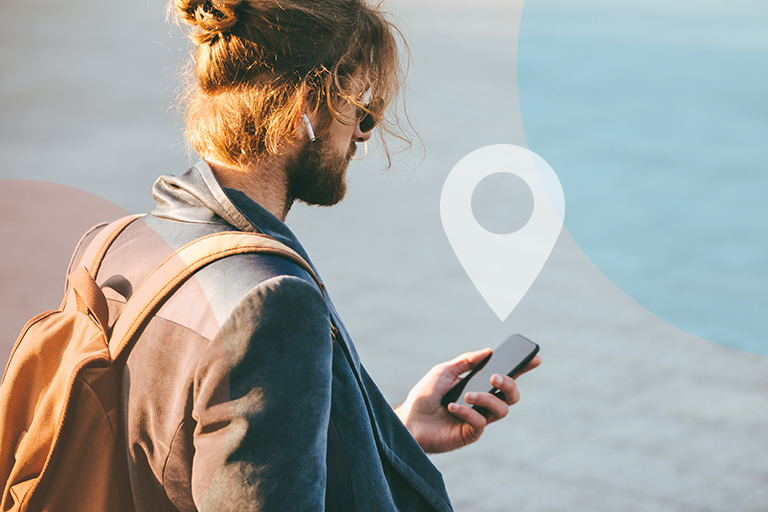Channel-agnostic, location-based marketing is when brands use location data to create individualized, unique content for each customer. This marketing strategy takes key data points like zip code, region, language, or time zone to pinpoint where customers are located. Then, brands can send customers marketing messages that resonate with their location.
When you add in channel specificity, however, location-based marketing can become even more effective. Take mobile, for example. Customers always have their phones with them—over 80% of the total global population carries a smartphone. And, because customers’ locations can be tracked through smartphones, location-based mobile marketing can become an extremely effective marketing tool. Let’s dig into how.
Why Use Location-Based Mobile Marketing?
It’s no surprise that the secret to creating a stand-out customer experience is to personalize your marketing messages for each individual customer. Because location-based mobile marketing is based on where each user’s mobile device is, it’s inherently personalized. In fact, according to a survey from Statista, 89% of respondents said location-based marketing increased sales, 86% of respondents said it improved the size of the customer base, and 84% pointed to increased customer engagement.
For example, a user in Ohio isn’t going to get the same messages as a person in Florida. This is a simple, high-level segmentation that will make a customer feel like you’re sending messages only to them. Take it a step further and personalize by zip code and you’ve got yourself a highly personalized marketing strategy, guaranteed to make your customers feel like they’re the center of every campaign.
Next, we’ll run through some of the different types of location-based mobile marketing that can help attract and delight your customers.
Types of Location-Based Mobile Marketing
There are a variety of types of location-based mobile marketing strategies that your brand can implement to increase personalization for each individual customer. Not only will location-specific marketing messages be more personal, but they’ll resonate better with the customer, increasing the chances for conversion.
Geo-Fencing
Geo-fencing is likely what you first think of when you hear “location-based mobile marketing.” Geo-fencing is when a brand sets a certain radius around specific locations—like their storefront—and then, when a customer enters that digitally fenced-in area, the brand can send specific marketing messages related to the central location.
You know when you’re going on vacation and your plane lands, your cell signal comes back, and you have a push notification specific to your location? That’s geofencing. It’s a large fence, sure, but it still qualifies. RetailMeNot, a platform to find the best coupons for a variety of stores, for example, provides coupons from stores in your immediate area, keeping relevance and value top of mind for every customer.
As another example, Radar, a geofencing platform, helps bridge the gap between digital and physical by helping brands reach customers on mobile when it makes the most sense. In our DBM video series, Nick Patrick, CEO and co-founder of Radar, highlights how a great customer experience needs to be frictionless, and how geofencing can contribute to a seamless, consistent experience.
“Effective marketing is all about reaching the right person with the right message at the right place and time, and the smartest mobile marketing teams use location as a critical input.” – Nick Patrick
Geo-Conquesting
Geo-conquesting is a way to use geo-fencing, but instead of using your own store as the fenced location, you can target shoppers at competitors’ locations, in the hopes they’ll turn on their heels and come to your store.
One of the most well-known examples of geo-conquesting is Burger King’s “Whopper Detour.” When customers were within 600 feet of a McDonald’s, customers who had the Burger King app—and notifications enabled—would get a push notification offering a coupon for a one-cent Whopper. Cutthroat, but brilliant. This campaign proved to be a huge success by driving 1.5 million app downloads.
Beacon Marketing
This type of location-based mobile marketing taps into the built-in Bluetooth on users’ phones. Beacon marketing uses physical devices—beacons—to communicate with nearby devices. So, for example, a store could have beacons set up to deliver information or promotions to shoppers’ phones as they walk by specific displays or products.
The hospitality industry (pre-COVID) had started to take advantage of beacon marketing. When hotel guests walk into a Starwood Hotels & Resorts location, for example, they would receive a digital room key sent directly to their mobile device via a beacon. Other hospitality brands use beacons to unlock hotel maps and answer guests’ questions. Beacons save time and money, making them an incredibly efficient form of location-based mobile marketing.
Connecting Locations Across Channels
While mobile may seem like the obvious choice to reach users with location-based marketing, the focus should always be to create a seamless experience, regardless of marketing channel. Location-based marketing can be applied to capture customers’ attention on their devices while they’re out and about, but that doesn’t mean it can’t be applied to a variety of marketing channels.
But, when a customer is on their phone, consider what they may be doing with it. What might they be looking for? How can your app improve their experience? Instead of flooding their home screens with vague, general messaging, be the brand that helps customers out with personal, unique, location-based mobile marketing.
To learn more about how Iterable can help bring your location-based cross-channel marketing strategy to life, schedule a demo today.































